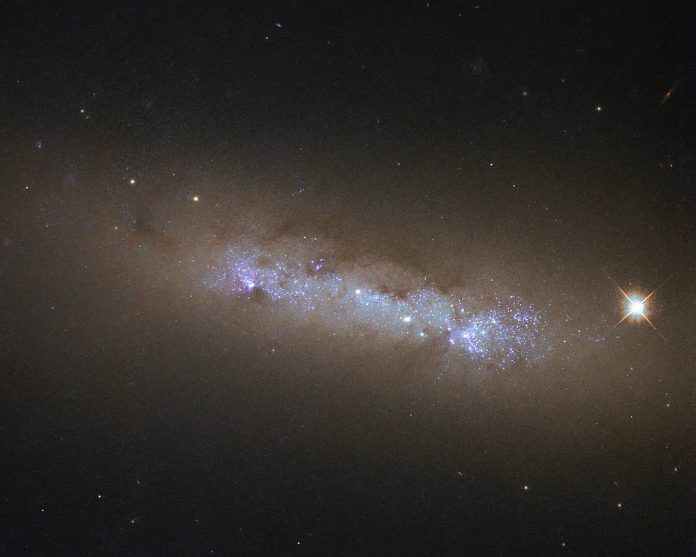Giovanni G. Fazio, Senior Physicist, Center for Astrophysics, tells us all about The Infrared Array Camera (IRAC) on the Spitzer Space Telescope
Our knowledge of the Universe and its constituents is based almost entirely on the electromagnetic radiation emitted by the Universe that is detected here on Earth.
This radiation ranges from gamma rays, which are very energetic and have a very short wavelength, through X-rays, ultraviolet, optical (visual), infrared, and radio radiation, which is much less energetic and has a very long wavelength. Each part of the spectrum yields a very different image and properties of the Universe. Astronomers combine these properties, like pieces of a puzzle, to yield a total picture of the Universe.
Of particular interest is the infrared part of the spectrum, which extends from the red region of the optical spectrum to the microwave region of the radio region. The infrared spectrum is of particular interest because it yields information on the following components of the Universe:
-
The cold Universe
Most objects are too cold to be observed in visible light and radiate primarily at infrared wavelengths.
-
The early Universe
Due to the expansion of the Universe, visible light emitted by stars and galaxies in the early Universe is shifted into the infrared spectrum. Infrared radiation is therefore important in observing the birth and evolution of the first stars and galaxies. In the Universe.
-
The dusty Universe
Dust in the Universe absorbs ultra-violet and optical light and re-emits it as infrared radiation. Therefore, infrared radiation is important in mapping the distribution of dust in the Universe. Infrared radiation can also penetrate clouds of dust. Thus proto-stars that are being born in the centre of dense clouds of molecular gas and dust can be observed at infrared wavelengths.
-
The chemical Universe
Many atoms and molecules radiate primarily at infrared wavelengths, yielding information on the chemistry of the Universe. In particular, organic molecules associated with living organisms radiate in the infrared. Infrared radiation is important in searching for evidence of life in the Universe.
Infrared radiation can be observed from the surface of the Earth only through a few atmospheric windows at near- and mid-infrared wavelengths. The Earth’s atmosphere absorbs most of the spectrum. Therefore, to observe the entire infrared spectrum space telescopes are required.
Infrared telescopes and detectors also need to cool to near liquid helium temperatures to reduce the background infrared radiation emitted at room temperatures. Placing a cooled infrared telescope in space not only permits full transmission of the spectrum but reduces the infrared background by a factor of one million.
Space telescopes also provide a very stable environment and long uninterrupted observing periods.
Spitzer Space Telescope
The Spitzer Space Telescope, one of NASA’s Great Observatories, was launched in 2003 to explore the infrared Universe. It was sent into a solar orbit, trailing just behind the Earth and gradually drifting away from it. It was equipped with a supply of ultracold liquid helium to cool both the telescope and its focal plane instruments. It was designed to investigate four major topics: the early Universe: brown dwarfs, the planet-forming debris disks surrounding newly-formed stars, and the extremely bright regions found at the centres of some galaxies.
The telescope had three cutting-edge focal plane instruments: the Infrared Array Camera (IRAC), the Multiband Imaging Photometer (MIPS), and the Infrared Spectrograph (IRS). At the end of the “cold mission” in 2009, when the liquid helium coolant was exhausted, Spitzer entered its “Warm Mission” phase. MIPS and IRS stopped working, but two of the four cameras in IRAC persisted with the same sensitivity. In 2016 the Spitzer Warm Mission was extended into its “Beyond” phase and in 2020 the mission was terminated.
Infrared Array Camera (IRAC)
When Spitzer was launched, IRAC provided a significant advance in the capabilities of space-based detectors, both in sensitivity and in areal coverage of the sky. IRAC is a four-channel camera that provides wide-field images over a range of four near- and mid-infrared wavelength bands. The two near-infrared wavelength bands are observed by indium antimonide array detectors (256X256 pixels) and the two mid-infrared wavelength bands by arsenic-doped silicon array detectors (256×256 pixels).
Two adjacent fields of view in the focal plane are viewed by the four channels in pairs, providing a very efficient means of large-area mapping of the sky. IRAC is a general-purpose camera that has been used by observers for a wide variant of astronomical research programs, including the study of solar system objects, star and planet formation, exoplanets, galaxies, and the early Universe. During the mission, IRAC has produced numerous striking astronomical images of a wide variety of astronomical objects and made many important discoveries.
IRAC’s important discoveries
IRAC has proved to be a powerful tool for detecting exoplanets and characterising their atmospheric temperatures. IRAC has the ability to find exoplanets using the transit method, looking for a dip in a star’s brightness as the planet passes in front of its star. IRAC’s stable environment and ability to observe stars for long periods of time has led to the first detection of light from a known exoplanet and the first temperature map of an exoplanet’s atmosphere.
This brightness change needs to be measured with extreme accuracy. Spitzer/IRAC’s best-known work may be detecting the seven Earth-size planets orbiting the red dwarf star TRAPPIST-1 – the largest number of terrestrial planets ever found orbiting a single star – and determining their masses and densities.
All seven of these planets are so close to their star that they would fit within the orbit of Mercury. Located about 40 light-years away, these seven rocky planets provide an example of the tremendous variety of planetary systems that fill the Universe.
Spitzer/IRAC has helped to find some of the most distant and ancient galaxies ever detected through their feeble infrared glow. Because of the finite speed of light, when we observe distant galaxies, we are observing back in time. IRAC has provided astronomers with a clearer window into how galaxies formed and evolved in the early Universe. Prior to IRAC’s observations, there was debate among astronomers about how and when the first galaxies formed after the Big Bang. Early estimates predicted the first galaxies formed approximately one billion years after the Big Bang. Spitzer and the Hubble Space telescope, operating at ultraviolet and visible wavelengths, have made significant progress towards solving this problem.
In a paper published in 2016, the Hubble Space Telescope and Spitzer/IRAC jointly described the detection of the galaxy GN-z11, observed as it existed 13.4 billion light-years ago, demonstrating that galaxy build-up was well underway earlier than 400 million years after the Big Bang. GN-z11 is the most distant known galaxy in the observable Universe. Its existence challenges current theories of how and when galaxies first formed.
Spitzer/IRAC observations measured the stellar mass of the galaxy to be approximately one billion times the mass of the Sun. It is amazing that this galaxy could be detected and its mass measured.
The fact that Spitzer/IRAC would detect objects such as TRAPPIST-1 and GN-z11was never even imagined when Spitzer was launched. The fact that these objects were detected is a result of nineteen years of effort before the launch and sixteen years of work during the flight by the scientist, engineers, and administrators who devoted themselves to this program.
Acknowledgements
The Spitzer Space Telescope is managed by the Jet Propulsion Laboratory, California Institute of Technology (Caltech) under a contract with NASA’s Science Mission Directorate. Science operations were conducted at the Spitzer Science Center at Caltech in Pasadena, California. Spacecraft operations were based at Lockheed Martin Space Systems Company, Littleton, Colorado. Data are archived at the Infrared Science Archive located at the Infrared Processing and Analysis Center (IPAC) at Caltech. For more information about Spitzer, visit http://spitzer.caltech.edu and http://www.nasa.gov/spitzer
IRAC was a joint project of the Smithsonian Astrophysical Observatory (SAO), NASA Goddard Space Flight Center (NASA/GSFC), University of Arizona (UA), University of Rochester (UR), Nasa Ames Research Center (NASA/Ames). The instrument was built at the NASA/GSFC. Additional information on IRAC can be found at https://lweb.cfa.harvard.edu/irac/.
Please note: This is a commercial profile
© 2019. This work is licensed under a CC BY 4.0 license.











